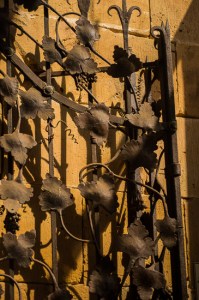Chasing Cathars — L’Abbaye de Fontfroide
 Since my first trip to the Languedoc-Rousillon in March, I’ve developed a fascination with the Cathars, sparked in part by reading some historical fiction and then digging a bit into their history. In the 12th century a group broke with the Catholic church in Rome and settled in this region of southwest France (also in northern and central Italy). They believed the papacy had perverted Christianity by its hierarchy and high living, contrary to the first Christian teachings. They were ascetics, sometimes called “Perfects,” for their strict moral code and vows of poverty, and they rejected the church’s sacraments and holy teachings. The Catholic church considered them a bigger threat even than the “infidel” Jews and Muslims.
Since my first trip to the Languedoc-Rousillon in March, I’ve developed a fascination with the Cathars, sparked in part by reading some historical fiction and then digging a bit into their history. In the 12th century a group broke with the Catholic church in Rome and settled in this region of southwest France (also in northern and central Italy). They believed the papacy had perverted Christianity by its hierarchy and high living, contrary to the first Christian teachings. They were ascetics, sometimes called “Perfects,” for their strict moral code and vows of poverty, and they rejected the church’s sacraments and holy teachings. The Catholic church considered them a bigger threat even than the “infidel” Jews and Muslims.
During the 13th century, the Benedictines, Cistercians and Dominicans all tried to preach the Cathars back into line, but the Perfects didn’t buy it. Impatient to eradicate this movement, Pope Innocent III (how ironic) commissioned the Albigensian crusade and recruited the bloodthirsty Simon de Montfort to lead it. Over the next 30-odd years the Cathars took refuge in remote chateaux as de Montfort’s troops systematically chased them down and rooted them out, putting the fortresses to siege, burning captured Perfects at the stake, and committing other atrocities.
You can visit at least twenty of these fortresses, most in ruins, in this area east of the Pyrenees. Some have been restored, such as Carcassonne and L’Abbaye de Fontfroide, where I went yesterday. I visited a few of them in March, when the weather was threatening, which added to the mystery and creepiness. Now, with temps in the low 80s and sunny skies, the atmosphere is very different.
Still, at Fontfroide, it takes little imagination to envision hooded monks gliding through the stone passageways. Though it’s considered part of the Cathar trail, this abbey was not a refuge for the Cathars: rather, it was a bastion of Catholic teaching, perhaps playing a role in trying to bring the heretics back into the fold.
The abbey prospered until the Black Death nearly wiped out the community in the mid-14th century. Over the succeeding centuries it struggled to survive, and was actually abandoned at least twice. In the early 20th century a private couple bought the abbey and carried out extensive renovations, including adding the remarkable stained glass in these photos, and opened it to the public. 





Those pictures of the stained glass are beautiful. Very informative post! I wondered who the Cathars were. Now I know. 🙂
What a journey you are having. It sounds as though you are feeding body, mind and spirit! Thanks for sharing.